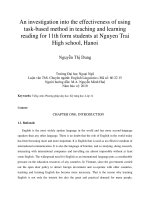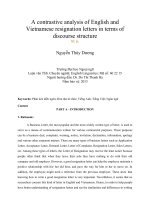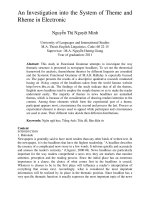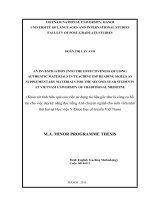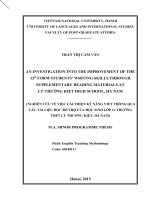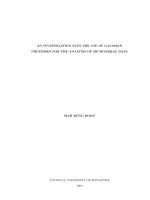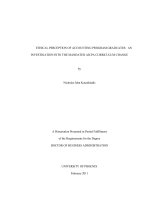An investigation into the use of gaussian processes for the analysis of microarray data
Bạn đang xem bản rút gọn của tài liệu. Xem và tải ngay bản đầy đủ của tài liệu tại đây (1.33 MB, 96 trang )
AN INVESTIGATION INTO THE USE OF GAUSSIAN
PROCESSES FOR THE ANALYSIS OF MICROARRAY DATA
SIAH KENG BOON
NATIONAL UNIVERSITY OF SINGAPORE
2004
AN INVESTIGATION INTO THE USE OF GAUSSIAN
PROCESSES FOR THE ANALYSIS OF MICROARRAY DATA
SIAH KENG BOON
(B.Eng.(Hons.), NUS)
A DISSERTATION SUBMITTED FOR
THE DEGREE OF MASTER OF ENGINEERING
DEPARTMENT OF MECHANICAL ENGINEERING
NATIONAL UNIVERSITY OF SINGAPORE
2004
To my family and friends
Acknowledgements
I wish to express my deepest gratitude and appreciation to my two supervisors,
Associate Professor Chong Jin Ong and Associate Professor S. Sathiya Keerthi for
their instructive guidance and constant personal encouragement during the period
of my research.
I gratefully acknowledge the financial support provided by the National University of Singapore through Research Scholarship that enabled my studies.
My appreciations also goes to Mr. Yee Choon Seng, Mrs. Ooi, Ms. Tshin,
Madam Hamidah and Mr. Zhang for the giving numerous facility support in the
laboratory, which help to complete the project smoothly.
I would like to thank my family and friends for their love and support through
my life.
I am also fortunate to have met many talented research fellows in the Control
Laboratory. I am sincerely grateful for their friendship, especially to Chu Wei, Lim
Boon Leong, Duan Kaibo, Manojit Chattopadhyay, Qian Lin, and Liu Zheng.
I also want to thank Shevade Shirish Krishnaji and Radford Neal for their help
in my research project.
iii
Table of contents
Acknowledgements
iii
Summary
vi
1 Introduction
1.1 Literature Review . . . . . . . . . . . . . . . . . . . . . . . . . . . .
1.2 Organization of Thesis . . . . . . . . . . . . . . . . . . . . . . . . .
1
2
4
2 Feature Selection
5
2.1 Fisher Score . . . . . . . . . . . . . . . . . . . . . . . . . . . . . . . 7
2.2 Information Gain . . . . . . . . . . . . . . . . . . . . . . . . . . . . 8
2.3 Automatic Relevance Determination . . . . . . . . . . . . . . . . . 10
3 Gaussian Processes
3.1 Gaussian Processes Model for Classification
3.2 Automatic Relevance Determination . . . .
3.3 Monte Carlo Markov Chain . . . . . . . . .
3.3.1 Gibbs Sampling . . . . . . . . . . . .
3.3.2 Hybrid Monte Carlo . . . . . . . . .
.
.
.
.
.
.
.
.
.
.
.
.
.
.
.
4 Microarrays
4.1 DNA Microarrays . . . . . . . . . . . . . . . . . .
4.1.1 cDNA Microarrays . . . . . . . . . . . . .
4.1.2 High Density Oligonucleotide Microarrays
4.2 Normalization . . . . . . . . . . . . . . . . . . . .
4.3 Datasets . . . . . . . . . . . . . . . . . . . . . . .
4.3.1 Breast Cancer Dataset . . . . . . . . . . .
4.3.2 Colon Cancer Dataset . . . . . . . . . . .
4.3.3 Leukaemia Dataset . . . . . . . . . . . . .
4.3.4 Ovarian Cancer Dataset . . . . . . . . . .
5 Implementation Issues of Gaussian Processes
5.1 Understanding on Gaussian Processes . . . . .
5.1.1 Banana Dataset . . . . . . . . . . . . .
5.1.2 ARD at work . . . . . . . . . . . . . .
5.1.3 Equilibrium State . . . . . . . . . . . .
5.1.4 Effect of Gamma Distribution . . . . .
5.1.5 Summary . . . . . . . . . . . . . . . .
.
.
.
.
.
.
.
.
.
.
.
.
.
.
.
.
.
.
.
.
.
.
.
.
.
.
.
.
.
.
.
.
.
.
.
.
.
.
.
.
.
.
.
.
.
.
.
.
.
.
.
.
.
.
.
.
.
.
.
.
.
.
.
.
.
.
.
.
.
.
.
.
.
.
.
.
.
.
.
.
.
.
.
.
.
.
.
.
.
.
.
.
.
.
.
.
.
.
.
.
.
.
.
.
.
.
.
.
.
.
.
.
.
.
.
.
.
.
.
.
.
.
.
.
.
.
.
.
.
.
.
.
.
.
.
.
.
.
.
.
.
.
.
.
.
.
.
.
.
.
.
.
.
.
.
.
.
.
.
.
.
.
.
.
.
.
.
.
.
.
.
.
.
.
.
.
.
.
.
.
.
.
.
.
.
.
.
.
.
.
.
.
.
.
.
.
.
11
12
16
17
19
20
.
.
.
.
.
.
.
.
.
24
24
26
27
29
29
30
30
31
31
.
.
.
.
.
.
32
32
32
33
35
38
39
iv
6 Methodology using Gaussian Processes
43
6.1 Feature Selection . . . . . . . . . . . . . . . . . . . . . . . . . . . . 43
6.2 Unbiased Test Accuracy . . . . . . . . . . . . . . . . . . . . . . . . 44
6.3 Performance Measure . . . . . . . . . . . . . . . . . . . . . . . . . . 45
7 Results and Discussions
48
7.1 Unbiased Test Accuracy . . . . . . . . . . . . . . . . . . . . . . . . 48
7.2 Feature Selection . . . . . . . . . . . . . . . . . . . . . . . . . . . . 54
8 Conclusion
58
References
60
Appendix
64
A Figures for Banana Experiments
65
B A Biased Design
76
B.1 Biased Test Accuracy . . . . . . . . . . . . . . . . . . . . . . . . . . 76
C Applying Principal Component Analysis on ARD values
81
v
Summary
Microarray technologies are powerful tools which allow us to quickly observe the
changes at the differential expression levels of the entire complement of the genome
(cDNA) under different induced conditions. Under these different conditions, it is
believed that important information and clues to their biological functions can be
found.
In the past decade, numerous microarray experiments were performed. However, due to the large amount of data, it is difficult to analyze the data manually.
Recognizing this problem, some researchers have applied machine learning techniques to help them understand the data (Alizadeh et al., 2000; Alon et al., 1999;
Brown et al., 2000; Golub et al., 1999; Hvidsten et al., 2001). Most of them tried
to do classification on these data, in order to differentiate two different possible
classes, e.g tumor and non-tumor or two different types of tumors. Generally, the
main characteristic of the microarray data is that it has large number of genes but
rather small number of examples. This means that it is possible to have a lot of
redundant and irrelevant genes in the dataset. Thus, it is useful to apply feature
selection tools to select a set of useful genes, before feeding into a machine learning techniques. These two areas, i.e. gene microarray classification and feature
selection, are the main tasks for this thesis.
We have applied Gaussian Processes with Monte Carlo Markov Chain (MCMC)
treatment as classification tool, and Automated Relevance Determination (ARD)
in Gaussian Processes as feature selection tool for the microarray data. Gaussian
Processes with MCMC treatment is based on a Bayesian probabilistic framework
to make prediction (Neal, 1997). It is a very powerful classifier and best suited for
vi
problem with a small number of examples. However, the application of Bayesian
modelling scheme into the interpretation of Microarray dataset is yet to be investigated.
In this thesis, we have used this machine learning to study the application of
Gaussian Processes with MCMC treatment in four datasets, namely Breast cancer
dataset, Colon cancer dataset, Leukaemia dataset and Ovarian cancer dataset.
It will be expensive to directly apply Gaussian Processes on the datasets. Thus,
filter methods, namely Fisher Score and Information Gain, are used for the first
level of feature selection process. Comparisons are done upon these two methods.
We have found out that these two filter methods, generally, gave comparable
results.
To estimate the quality of the selected feature, we use the technique of external cross-validation (Ambroise and McLachlan, 2002), which gives an unbiased
average test accuracy. In this technique, the training data is split into different
folds. The gene selection procedure is executed, each time using training dataset
that excludes one fold. Testing will be done on the fold omitted. From this average test accuracy, the combination of filter methods and ARD feature selection
methods gives results that are comparable to those in the literature (Shevade and
Keerthi, 2002). Though it is expected that average test accuracy is higher than
validation test accuracy, the average test accuracy obtained is also considerably
good, particularly in Breast Cancer dataset and Colon Cancer Dataset.
vii
List of Figures
2.1
2.2
Architecture of wrapper method. . . . . . . . . . . . . . . . . . . .
Architecture of filter method. . . . . . . . . . . . . . . . . . . . . .
6
6
4.1
A unique combination of photolithography and combinatorial chemistry . . . . . . . . . . . . . . . . . . . . . . . . . . . . . . . . . . . 28
5.1
5.2
5.3
5.4
5.5
5.6
5.7
5.8
5.9
5.10
5.11
Values of Θ for original Banana datasets . . . . . . . . . . . . . . .
Location of all the original examples in the feature space. . . . . . .
Location of all the training examples in the feature space. . . . . . .
Location of all training and testing examples in the feature space. .
Values of Θ for Banana datasets, with redundant features. . . . . .
Values of Θ for Banana datasets, with redundant features. . . . . .
Box plot of testing example 4184 along iteration of MCMC samplings.
Box plot of testing example 864 along iteration of MCMC samplings.
Box plot of testing example 2055 along iteration of MCMC samplings.
Box plot of testing example 4422 along iteration of MCMC samplings.
Values of Θ for Banana datasets, with prior distribution that fails
to work. Only last 500 is shown here. . . . . . . . . . . . . . . . . .
33
35
36
37
38
39
40
40
41
41
A.1 Location of training and testing examples in the feature space. . . .
A.2 Box plot of testing example 3128 along iteration of MCMC samplings.
A.3 Box plot of testing example 864 along iteration of MCMC samplings.
A.4 Box plot of testing example 3752 along iteration of MCMC samplings.
A.5 Box plot of testing example 1171 along iteration of MCMC samplings.
A.6 Box plot of testing example 139 along iteration of MCMC samplings.
A.7 Box plot of testing example 4183 along iteration of MCMC samplings.
A.8 Box plot of testing example 829 along iteration of MCMC samplings.
A.9 Box plot of testing example 4422 along iteration of MCMC samplings.
A.10 Box plot of testing example 3544 along iteration of MCMC samplings.
A.11 Box plot of testing example 1475 along iteration of MCMC samplings.
A.12 Box plot of testing example 2711 along iteration of MCMC samplings.
A.13 Box plot of testing example 768 along iteration of MCMC samplings.
A.14 Box plot of testing example 576 along iteration of MCMC samplings.
A.15 Box plot of testing example 1024 along iteration of MCMC samplings.
A.16 Box plot of testing example 1238 along iteration of MCMC samplings.
A.17 Box plot of testing example 4184 along iteration of MCMC samplings.
A.18 Box plot of testing example 1746 along iteration of MCMC samplings.
A.19 Box plot of testing example 2055 along iteration of MCMC samplings.
65
66
67
67
68
68
69
69
70
70
71
71
72
72
73
73
74
74
75
42
C.1 ARD values for Robotic Arm dataset without noise. . . . . . . . . . 82
viii
C.2 ARD values for Robotic Arm dataset with noise. . . . . . . . . . . . 83
ix
List of Tables
6.1
Three Measure of Performance . . . . . . . . . . . . . . . . . . . . . 45
7.1
Results of the unbiased test accuracy methodology for Breast Cancer Dataset-Fisher Score and ARD . . . . . . . . . . . . . . . . . .
Results of the unbiased test accuracy methodology for Breast Cancer Dataset-Information Gain and ARD . . . . . . . . . . . . . . . .
Results of the unbiased test accuracy methodology for Colon Cancer
Dataset-Fisher Score and ARD . . . . . . . . . . . . . . . . . . . .
Results of the unbiased test accuracy methodology for Colon Cancer
Dataset-Information Gain and ARD . . . . . . . . . . . . . . . . . .
Results of the unbiased test accuracy methodology for Leukaemia
Dataset-Fisher Score and ARD . . . . . . . . . . . . . . . . . . . .
Results of the unbiased test accuracy methodology for Leukaemia
Dataset-Information Gain and ARD . . . . . . . . . . . . . . . . . .
Results of the unbiased test accuracy methodology for Ovarian Cancer Dataset-Fisher Score and ARD . . . . . . . . . . . . . . . . . .
Results of the unbiased test accuracy methodology for Ovarian Cancer Dataset-Information Gain and ARD . . . . . . . . . . . . . . . .
Comparison for different dataset with the Sparse Logistic Regression method of Shevade and Keerthi (2002) . . . . . . . . . . . . . .
Comparison for different dataset with Long and Vega (2003) with
gene limited at 10 . . . . . . . . . . . . . . . . . . . . . . . . . . . .
Feature selection method used in different dataset . . . . . . . . . .
Optimal number of features on different dataset . . . . . . . . . . .
Selected genes for the breast cancer based on fisher score with ARD
Selected genes for the breast cancer dataset based on Information
Gain with ARD . . . . . . . . . . . . . . . . . . . . . . . . . . . . .
Selected genes for the colon cancer dataset based on Information
Gain with ARD . . . . . . . . . . . . . . . . . . . . . . . . . . . . .
Selected genes for the leukaemia dataset based on fisher score with
ARD . . . . . . . . . . . . . . . . . . . . . . . . . . . . . . . . . . .
Selected genes for the ovarian cancer dataset based on fisher score
with ARD . . . . . . . . . . . . . . . . . . . . . . . . . . . . . . . .
7.2
7.3
7.4
7.5
7.6
7.7
7.8
7.9
7.10
7.11
7.12
7.13
7.14
7.15
7.16
7.17
49
49
50
50
51
51
52
52
53
54
55
55
55
56
56
57
57
B.1 Results of the biased test accuracy methodology for Breast Cancer
Dataset-Fisher Score and ARD . . . . . . . . . . . . . . . . . . . . 77
B.2 Results of the biased test accuracy methodology for Breast Cancer
Dataset-Information Gain and ARD . . . . . . . . . . . . . . . . . . 78
B.3 Results of the biased test accuracy methodology for Colon Cancer
Dataset-Fisher Score and ARD . . . . . . . . . . . . . . . . . . . . 78
x
B.4 Results of the biased test accuracy methodology for Colon Cancer
Dataset-Information Gain and ARD . . . . . . . . . . . . . . . . .
B.5 Results of the biased test accuracy methodology for Leukaemia
Dataset-Fisher Score and ARD . . . . . . . . . . . . . . . . . . .
B.6 Results of the biased test accuracy methodology for Leukaemia
Dataset-Information Gain and ARD . . . . . . . . . . . . . . . . .
B.7 Results of the biased test accuracy methodology for Ovarian Cancer
Dataset-Fisher Score and ARD . . . . . . . . . . . . . . . . . . .
B.8 Results of the biased test accuracy methodology for Ovarian Cancer
Dataset-Information Gain and ARD . . . . . . . . . . . . . . . . .
. 78
. 79
. 79
. 79
. 80
C.1 Results of PCA based on Robotic Arm without noise . . . . . . . . 82
C.2 Results of PCA based on Robotic Arm with noise . . . . . . . . . . 83
xi
Chapter 1
Introduction
In the recent years, biological data are being produced at a phenomenal rate.
On average, the amount of data found in databases such as GenBank double in
less than 2 years time (Luscombe et al., 2001). Besides, there are also many
other projects, closely related to the gene expression studies and protein structure
studies, that are adding numerous amount of information to the field. This surge in
data has heightened the need to process them. As a result, computers have become
an indispensable element to biological research. Since the advent of information
age, computers are used to handle large quantities of data and investigate complex
relations, which may be observed in the data. The combination of these two fields
has given rise to a new field, Bioinformatics.
The pace of data collection has been once again speeded up with the arrival of
DNA microarray technologies (Genetics, 1999). It is one of the new breakthroughs
in experimental molecular biology. With thousands of gene expression processed
in parallel, microarray techniques are producing huge amount of valuable data
rapidly. The raw microarray data are images, which are then transformed to
gene expression matrices or tables. These matrices have to be evaluated if further
knowledge concerning the underlying biological process is to be extracted out. As
the data is huge, studying the microarray data manually is not possible. Thus, to
evaluate and classify the microarray data, different methods in machine learning
are used, both supervised and unsupervised methods (Bronzma and Vilo, 2001).
1
In this thesis, the focus will be on a supervised method, i.e. the outputs of the
training examples are known and the purpose is to predict the output of new
example. In most of the cases, the outputs are either of two classes. Hence, the
task is to classify a particular example of the microarray data, predicting it to
be tumor or non-tumor (Colon Cancer dataset), or differentiating it between two
different cancer types (Leukaemia dataset).
In most cases, the number of examples in a typical microarray data set is
small. This is so because the cost of applying and evaluating different conditions
and evaluating on the samples is relatively high. Yet, the data is very large due
to the huge number of genes involved, ranging from a few thousands to hundreds
of thousands. Thus, it is expected that most of the genes are irrelevant or redundant. Generally, these irrelevant and redundant features would not be helpful in
the prediction process. In fact, there are many cases in which irrelevant and redundant features decrease the performance of the machine learning algorithm. Thus,
feature selection tools are needed. It is hoped that by applying feature selection
methods on microarray datasets, we are able to eliminate a substantial number of
irrelevant and redundant features. This will improve the machine learning process
as well as reduce the computational effort required. This is the motivation of the
thesis.
1.1
Literature Review
There are several papers working on these two areas, i.e., gene microarray classification and feature selection in gene microarray datasets. Furey et al. (2000) have
employed Support Vector Machines to classify three datasets, which are Colon
Cancer, Leukaemia and Ovarian datasets. Brown et al. (2000) also applied Support Vector Machines in gene Microarray datasets. Even though the number of
examples available is low, the authors are still able to obtain low testing errors.
Thus, the method is popular. Besides Support Vector Machines, Li et al. (2001a)
have combined a Genetic Algorithm and the k-Nearest Neighbor method to dis-
2
criminate between different classes of samples, while Bendor et al. (2000) used a
Nearest Neighbor method with Pearson Correlation. Nguyen and Rocke (2002)
used Logistic Discrimination and Quadratic Discriminant Analysis for predicting
human tumor samples. Naive Bayes method (Keller et al., 2000) is also employed.
Also, Dudoit and Speed (2000) employed a few methods, namely, Nearest Neighbor, Linear Discriminant Analysis, Classification tree with Boosting, and Bagging for gene expression classification. Meanwhile, Shevade and Keerthi (2002)
have proposed a new and efficient algorithm based on Gauss-Seidel method to
address gene expression classification problem. Recently, Long and Vega (2003)
used Boosting methods to obtain cross validation estimates for the Microarray
datasets.
For gene selection, Furey et al. (2000), Golub et al. (1999), Chow et al. (2001)
and Slonim et al. (2000) made used of Fisher Score as the gene selection tool.
Weston et al. (2000) also used information in kernel space of Support Vector
Machines as a feature selection tool to compare with Fisher Score. Guyon et al.
(2002) have introduced Recursive Feature Elimination based on Support Vector
Machines to select relevant genes in gene expression data. Besides, Li et al. (2001b)
has used Automated Relevance Determination (ARD) of Bayesian techniques to
select relevant genes. Ben-Dor et al. (2000) have examined Mutual Information
Score, as well as Threshold Number of Misclassification to find relevant features
in gene microarray data.
In this thesis, we will investigate the usefulness of Gaussian Processes with
Monte Carlo Markov Chain (MCMC) treatment, as the classifier for the microarray datasets. Gaussian Processes is an attractive method for several reasons. It
is based on the Bayesian formulation and such a formulation is known to have
good generalization property in many implementations. Instead of making point
estimates (Li et al., 2001b), the method makes use of MCMC to sample on the
evidence distribution. Besides this probabilistic treatment, it is also a well known
fact that the method performs well with small number of examples and many features. We will also make use of the Automated Relevance Determination (ARD)
3
that is inherent in Gaussian Processes as the feature selection tool. We will discuss
Gaussian Processes, MCMC and ARD in detail in Chapter 3.
As mentioned, we have used the probabilistic framework of Gaussian Processes,
with the external cross validation methodology to predict as well as select relevant
features. Based on the design, we can observe encouraging results. Except for the
Leukaemia dataset, the results of the other three datasets show that the methodology perform competitively, compared with the results of Shevade and Keerthi
(2002). However. we would like to emphasize that it is not the aim of this project
to solve the problem and come out with a set of genes which we will claim as the
cause of cancers. But, we would like to highlight a small number of genes which
the Gaussian Processes methodology, have identified as the relevant genes in the
data. We hope that this method can be a tool to help the biologists shorten their
time to find out the genes responsible of certain disease. With the knowledge gain,
they may apply necessary procedures or drugs to prevent the disease.
1.2
Organization of Thesis
The thesis is arranged in the following way. Chapter 2 describes feature selections
methods for two classes problem, which are used in the thesis. An introduction
of Gaussian Processes is given in Chapter 3. Gaussian Processes is a learning
model for regression and classification tasks with a Bayesian framework. This
framework is described in detail. Also, MCMC and ARD will be discussed in
Chapter 3 as well. In Chapter 4, DNA microarray technology will be briefly
mentioned, together with a short description of the four microarray datasets used
throughout the thesis. Then, Chapter 5 describes some experiments to gain a
better understanding on the Gaussian Processes. Chapter 6 concentrates on the
methodology of the experiments. Then, the results and discussions based on the
results obtained are covered in Chapter 7. Lastly, the conclusions of the thesis are
in Chapter 8.
4
Chapter 2
Feature Selection
The microarray data are known to be of very high dimension (corresponding to
the number of genes) and having few examples. Typically, the dimension is in the
range of thousands or tens of thousands while the number of examples lies in the
range of tens. Many of these features are redundant and irrelevant. Thus, it is
a natural tactic to select a subset of features (i.e. the genes in this case) using
feature selection.
Generally, feature selection is an essential step that removes irrelevant and
redundant data. Feature selection methods can be categorized into two common
approaches: the wrapper method and the filter method (Kohavi and John, 1996;
Mark, 1999).
Wrapper method includes the machine-learning algorithm in evaluating the
importance of features in predicting the outcome. This method is supported with
the thought that bias of a particular induction algorithm should be taken into
account when selecting features. A general wrapper architecture is described in
Figure 2.1.
Wrapper method conducts a search on the number of input features. The
techniques used can be forward selection (a search begins with the empty set of
features and add in feature or a set of features with certain criteria), backward
elimination (a search begins with the full set of features) or best first search (a
search that allows backtracking along search path). Wrapper method will also
5
Figure 2.1: Architecture of wrapper method.
Figure 2.2: Architecture of filter method.
require feature evaluation function together with the learning algorithm to estimate the final accuracy of feature selection. The function can be a re-sampling
technique such as k-fold cross validation or leave-one-out cross validation. Since
wrapper method is tuned to interactions between an induction algorithm and its
training data, it generally gives better results than filter method. However, to
provide such an interaction, the learning algorithm is repeatedly called. This, in
practice, may be too slow and computationally expensive for large datasets.
As for filter method, a heuristic is used, which is based on the characteristics
of the data, to evaluate the usefulness of the features before evaluation with the
learning algorithm. Independently on the learning algorithm, filter method is
generally much faster than wrapper method. Thus, it is suitable for data of high
dimensionality and many features. A general filter architecture is shown in Figure
2.2.
For most of the cases, filter method fails to recognize the correlation among
the features. Filter method also requires the user to set a level of acceptance on
6
choosing the features to be selected, which requires experience of the user.
In this project, before applying Automated Relevance Determination (ARD),
we use filter methods to reduce the number of features. This is mainly to avoid
the huge dimension of the raw data to be fed into Gaussian Processes. The filter
method that is being used here is Fisher Score and Information Gain. These two
filter methods are widely used in Pattern Recognition for two-class problems. We
will discuss these two filter methods in the next two sections.
2.1
Fisher Score
Fisher Score is an estimate of how informative a given data is, based on means and
variances of two classes of the data. The method is only suitable for continuous
values with two classes. The formulation of the Fisher Score is given as
F isherScore =
(µ1 − µ2 )2
σ12 + σ22
(2.1)
where µi and σi are the mean and standard deviation of data from class i.
The numerator of (2.1) is a measure of the distance between the two means of
classes. Intuitively, if the two means are far apart, it is easier for the data to be
recognized as two classes. Thus, if the numerator value is high, it means that the
data is informative to differentiate the class.
However, just using the means are not sufficient. For example, a feature is
not a strong feature if its means of the two classes are very much different and,
at the same time, the variances of the two classes are also huge (i.e. the data of
each class are widely spread). The situation will be even worse if the variance is
so huge that there is much overlap region of the data. Thus, the denominator of
(2.1) is introduced to overcome this situation.
Thus, Fisher Score is a measurement of the data in term of its distribution.
The value of the score is high if the two means of the classes are very different and
the data of each class are crowded near the mean of the data.
7
Fisher Score has been widely used in the microarrays data as the filter method
for the reduction in the number of features (Golub et al., 1999; Weston et al., 2000;
Furey et al., 2000; Chow et al., 2001; Slonim et al., 2000). Though the expression
may differ from (2.1), the essential meaning is pretty similar. A summary of the
expressions of Fisher Score used in the literature are given below:
1. Golub et al. (1999); Chow et al. (2001),
(µ1 − µ2 )
σ1 + σ2
(2.2)
(µ1 − µ2 )
|
σ1 + σ2
(2.3)
|µ1 − µ2 |
σ1 + σ2
(2.4)
2. Furey et al. (2000),
|
3. Slonim et al. (2000),
In the thesis, we will use (2.1).
2.2
Information Gain
Information gain is a filter method that is based on entropy (information theory). Entropy is a measurement of uncertainty in a system. The entropy of a
distribution, x, is given by
H(x) = −
p(x)log2 (p(x))
(2.5)
x
where p(x) is the probability for x to happen.
However, entropy can also be used as a measure of independency. For this
purpose, let x be the feature and t be the class. To check the entropy of a joint
event when a feature occurs together with the class, the joint entropy is given as
H(x, t) = −
p(x, t)log2 (p(x, t))
x
(2.6)
t
8
where p(x, t) is the joint probability for (x, t) to occur.
Equations (2.5) and (2.6) are used for computing the information gain of a
feature and the class, which is given as
Inf ormation Gain =
p(x, t)log2
x
t
(p(x, t))
p(x)p(t)
(2.7)
Equation (2.7) is simply a measure of the reduction in uncertainty about a
variable (for example, the feature in this case) due to the knowledge of another
variable (the class in this case )(Duda et al., 2001). Thus, it is actually a measure
of how much the distributions of the variables (the class and a feature) differ from
statistical independency of these two variables.
The value of information gain is always greater than zero. From (2.7), it can
be observed that if the class and the feature are independent, the value of mutual
information is equal to zero. Hence, the greater the values of information gain,
the higher the correlation between a feature and the class.
However, in most cases, the distributions of variables are not known. In order
to use information gain, there is a need to discretize the gene expression values.
In this project, we employed the Threshold Number of Misclassification (TNoM)
method suggested by Ben-Dor et al. (2000) as the discretization method. It is
based on the simple rule that uses the value, x,of expression level of a gene. The
prediction class, t, is simply sign(ax + b), where a (−1, +1). A straightforward
approach is to find out the values of a and b that minimize the number of errors.
Thus,
Err(a, b|x) =
1{ti = sign(axi + b)}
(2.8)
i
which means if the prediction and the label of an example are different, error is
increased by one.
In this case, instead of using the (a, b) which give minimum errors of misclassification, the (a, b) that give the maximum value of information gain over the
various possible discretizations is used. Once (a∗ , b∗ ) are found after 2(n + 1)
possible search (where n is the number of possible values of x), information gain
9
(2.7) can be found too. In short, TNoM (2.8) is used as a binning method before
Equation (2.7) is applied.
2.3
Automatic Relevance Determination
We will discuss this feature selection method in Chapter 3, as it is closely related
to Gaussian Processes.
10
Chapter 3
Gaussian Processes
This chapter presents a review on Gaussian Processes. It is first inspired by Neal’s
work (Neal, 1996) on priors for infinite networks. In spirit, Gaussian Processes
models are equivalent to a Bayesian treatment of a certain class of multi-layer
perceptron networks in the limit of infinitely large networks (i.e. with an infinite
number of hidden nodes). This is shown experimentally by Neal (Neal, 1996). In
Bayesian approach to neural networks, a prior on the weights in the network induces a prior distribution over functions. When the network becomes very large,
the network weights are not represented explicitly. The priors of these weights
are represented a simpler function in Gaussian Processes treatment. The mathematical development of this can be found in Williams (1997). Thus, Gaussian
Processes achieves an efficient computation of prediction based on a stochastic
process priors over functions.
The idea of having prior distribution over the infinite-dimensional space of
possible functions have been known for many years. O’Hagan (O’Hagan, 1978)
has used Gaussian priors over functions for his development. Generalized radial
basis functions (Poggio and Girosi, 1989), ARMA models (Wahba, 1990) and
variable metric kernel methods (Lowe, 1995) are all closely related to Gaussian
Processes. The same model has long been used in spatial statistics known as
“kriging” (Journel and Huijbregts, 1978; Cressie, 1991).
The work by Neal (Neal, 1996) has motivated examination of Gaussian Pro11
cesses for the high dimensional applications to which neural networks are typically
applied, both on regression and classification problems (Williams and Rasmussen,
1996; Williams and Barber, 1998; Gibbs, 1997).
One of the common DNA microarray problems is the classification problem
based on gene expressions (i.e. differential expression levels of the gene under
different induced conditions). The task is to use the gene expression levels to
classify groups to which an example belongs. There are a few classification methods that use Gaussian Processes: Laplace approximation (Williams and Barber,
1998), Monte Carlo method (Neal, 1997), variational techniques (Gibbs, 1997;
Seeger, 1999) and mean field approximations (Opper and Winther, 1999). For
this thesis, we will mainly focus on Neal’s work which uses the technique of Monte
Carlo Markov Chain (MCMC). Thus, in the following sections of this chapter, we
will discuss the classification model based on MCMC Gaussian Processes.
3.1
Gaussian Processes Model for Classification
We now provide a review of the Gaussian Processes methodology and the associated nomenclature. See Neal (1996) for detailed discussion of this method.
We will use the following notations. x with d dimension is a training example.
n is the total number of training examples. Let {x}n denotes the n example of
inputs, x. The true label is denoted as t. T denotes n numbers of training data,
both inputs ({x}n ) and outputs (true labels). The Gaussian Processes for classification is based on the regression methodology. In the regression methodology,
the predicting function of the regression is y(x), which is also known as latent
function. Y = {y(x1 ), y(x2 ), . . . , y(xn )} denotes n numbers of latent functions. cij
is the covariance function of input xi and xj . C is the covariance function matrix
with elements cij . Let us denote the prediction of the input as t(x), which only
take two values (i.e. +1 or 0). x∗ denotes the testing input. Accordingly, t(x∗ ) is
the predicting label of testing input.
Gaussian Processes is based on Baye’s rule, for which a set of probabilistic
12
models of the data is specified. These models are used to make predictions. Let’s
denote an element of the set (or one model) by H, with a prior probability, P (H).
When the data, T , is observed, the likelihood of H is P (T |H). By Baye’s rule,
the posterior probability of H is then given by
posterior ∝ prior × likelihood
(3.1)
P (H|T ) ∝ P (H) × P (T |H)
(3.2)
The main idea of Gaussian Processes is to predict the output y(x) for a given
x. Each model, H, is related to y(x) by P (y(x)|H). Hence, if we have a set of
probabilistic models, a combined prediction of the output y(x) is
P (y(x)|H) × P (H|T )
P (y(x)|T ) =
(3.3)
allH
In the above, y(x) is typically a regression output, i.e., y(x) is a continuous
output. This output is also known as latent function. For a classification problem,
the above has to be expanded.
In a typical two-class classification problem, we assign a testing input, x∗ , to
class 1 if
P (t(x∗ ) = +1|T )
(3.4)
is greater than 0.5 and class 2 (i.e. true label is 0) otherwise.
We can find (3.4) by using a sigmoidal function over the latent function y(x∗ ),
through a transfer function, in the following manner
P (t(x∗ ) = +1|T )
=
P (t(x∗ ) = +1|y(x∗ ))P (y(x∗ )|T ) dy(x∗ )
(3.5)
where
P (t(x∗ ) = +1|y(x∗ ))
(3.6)
13


